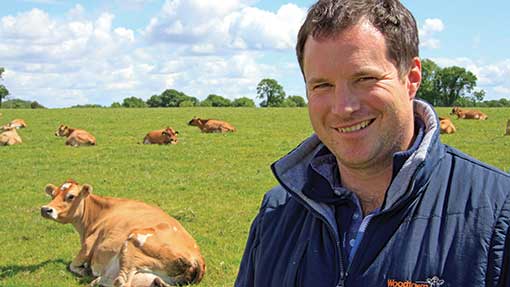Jersey cows produce profits from milk solids in Ireland

As the focus moves from litres to solids in Ireland, dairy farmer Ben Tyrrell is taking advantage of the flexibility the Jersey breed offers, to suit both milk price and input costs.
As part of Keenan’s three-day conference to mark its 30th anniversary, delegates visited Mr Tyrrell’s 108ha dairy farm in Kildalkey, Co Meath, where he farms 200 pedigree Jerseys with his father, Richard. Popularity of the breed is growing in Ireland and with a feed conversion efficiency of 1.51, they are proving effective converters of feed into milk solids.
“We need a breed to suit the milk payments system. Everyone gets a base price of 39c, but with the Jerseys we’re achieving 56c/litre plus a winter bonus from Baileys Irish Cream of 10c/litre,” says Mr Tyrrell.
The 50:50 autumn and spring block-calving herd averages 6,052 litres a cow (sold) at 5.9% butterfat and 4.2% protein. The Tyrrell’s receive their milk cheques on an A+B-C basis: A is the price paid in €/kg of protein, B is the price paid in €/kg of fat and C is a processing cost deduction of 4c a litre. In order to minimise penalties on the C figure, Mr Tyrrell needed a breed that produced high levels of constituents without volume.
“Jerseys are the most feed efficient – they’re yielding 2.2kg of solids a cow a day from an average of 22 litres. I’m selling more solids a cow and the cow is eating a lot less,” he says.
Mr Tyrrells milkers eat 17.5-18kg dry matter (DM) and are averaging the same solids (sold) as Holstein Friesians that may be eating 5kg DM more, he explains. The Jerseys are particularly well suited to seasonal grazing, as they can continue to consume a similar amount of DM on grass (15kg DM), where Holstein Friesians will have a big drop in DM intake, as they simply can’t eat enough grass, he adds.
Another benefit of the Jersey is its ability to adapt and perform well on either high- or low-input systems. Historically, Mr Tyrrell has used his margin-over-concentrate figure as a management tool to measure performance of the herd, which currently sits at €10.50 a cow.
“I keep a target margin-over-concentrate figure of €7.50 in mind, including youngstock, then I know where I am. I can make money at a lower level than this, but feel comfortable here, as I am more confident in my ability to deal with volatility.”
While the milk price is strong, Mr Tyrrell explains that he makes the most of the higher price by feeding a higher-energy ration, either as a total mixed ration during winter housing or – as of last year, – as a small but energy-dense buffer in the summer.
“Feeding energy pushes the protein constituent and as this is double the value of fat, it is well worth doing,” he adds.
If the margin falls below €7.50 Mr Tyrrell knows he needs to rein things in a bit. Likewise, if the milk price crashes, cows can go out to grass on a low-cost system, saving on the expense of concentrates, while still getting high solids with low volumes.
Ration changes
Mr Tyrrell has also focused on increasing the more inexpensive energy content to maximise outputs.
“It’s cheaper to put in maize meal than soya and we’re still seeing the fertility and milk constituent benefits.
“Cows peak at 28 litres and stay around 22-24 litres for a long time so they’re not under stress in negative energy deficit at service,” he says.
The summer buffer consists of a small amount of grass silage but is energy dense. It also has 0.5kg straw, 0.5kg molasses, wheat, maize meal, protein, megalac and 5kg water.
“I keep an edge on them so they eat as much grass as possible, selecting either a 4kg, a 6kg or an 8kg pre-set diet on the mixer wagon, depending on grass availability and weather conditions,” says Mr Tyrrell.
Soya has also been removed from the heifer diet and instead Mr Tyrrell uses rape, distillers and wheat, costing 85c a head a day to feed [including silage and straw]. “I was nervous, but they’ve grown very well on it,” he adds.
His future focus is to expand to 300 head and he would like to develop his grassland management.
“I’m improving paddock grazing techniques and opening up to a more low cost system as I go along. Years ago we looked for litres, now we concentrate on margins. You don’t have to be getting massive yields to make money,” concludes Mr Tyrrell.
| Ration detail | |||
|---|---|---|---|
| Milking ration/head (kg) | Heifer ration/head (kg) | ||
| Grass silage | 18 | Grass silage | 16.5 |
| Maize silage | 7 | Protein blend | 1.3 |
| Protein blend | 5.5 | Crimped wheat | 1.1 |
| Maize meal | 3 | Straw | 0.5 |
| Barley | 1.65 | Minerals | 0.1 |
| Molasses | 0.9 | ||
| Straw | 0.7 | ||
| Minerals /Megalac/ Limestone | 0.57 | ||
See also: How a Cheshire farmer is boosting yield from grass
